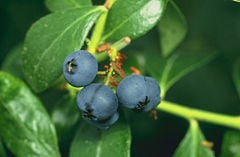Blueberry
| Blueberry | ||||||||||||
|---|---|---|---|---|---|---|---|---|---|---|---|---|
 Blueberry fruit | ||||||||||||
| Scientific classification | ||||||||||||
| ||||||||||||
| Species | ||||||||||||
|
See text |
Blueberries are a group of flowering plants in the genus Vaccinium, sect. Cyanococcus. The species are native to North America and eastern Asia. They are shrubs varying in size from 10 cm tall to 4 m tall; the smaller species are known as "lowbush blueberries", and the larger species as "highbush blueberries". The leaves can be either deciduous or evergreen, ovate to lanceolate, and from 1-8 cm long and 0.5-3.5 cm broad. The flowers are bell-shaped, white, pale pink or red, sometimes tinged greenish. The fruit is botanically a true berry 5-16 mm diameter with a flared "crown" at the end; they are pale greenish at first, then reddish-purple, and finally turn blue or dark purple on ripening. They have a sweet taste when mature, with variable acidity.
Other sections in the genus include other wild shrubs producing edible berries such as cranberries, bilberries and cowberries.
The blueberry season typically runs from May to October, peaking in July.
- Species
- Vaccinium angustifolium (Lowbush Blueberry)
- Vaccinium boreale
- Vaccinium caesariense
- Vaccinium corymbosum (Northern Highbush Blueberry)
- Vaccinium darrowii (Southern Highbush Blueberry)
- Vaccinium elliottii (Elliot Blueberry)
- Vaccinium formosum
- Vaccinium fuscatum (Black Huckleberry; syn. V. atrococcum)
- Vaccinium hirsutum (Hairy-fruited Blueberry)
- Vaccinium koreanum
- Vaccinium myrsinites (Evergreen Blueberry)
- Vaccinium myrtilloides (Canadian Blueberry)
- Vaccinium pallidum (Dryland Blueberry)
- Vaccinium simulatum
- Vaccinium tenellum (Southern Blueberry)
- Vaccinium virgatum (Rabbiteye Blueberry; syn. V. ashei)
Uses
Blueberries are used in jellies, jams, and pies, baked into muffins, and are an ingredient of many other snacks and delicacies. Some baked products incorporate artificial blueberries, which contain no actual blueberry.
Blueberry jam is a jam made out of blueberries, sugar and water, and fruit pectin. Commercial jams often contain chemical preservatives like citric acid. Premium artisanal blueberry jam is produced in Canada and the United States from wild blueberries, which are smaller and more difficult to harvest but more intensely flavoured than cultivated blueberries. Most production is in Maine, northwestern Ontario, and in the Saguenay-Lac-Saint-Jean region of Quebec.
Blueberries, especially wild species, contain antioxidants which have been found to reduce the risks of some cancers. At the 2004 International Conference on Longevity, a group of researchers released details of a study that suggests certain compounds found in blueberries (and some similar fruits, including cranberries) have a significant impact in reducing the degradation of brain function, as in Alzheimer's Disease and other conditions ([1], [2]). Research at Rutgers [3] has also shown that blueberries may help prevent urinary tract infections.
140 grams of fresh blueberries contain 3 g of fibre[4].
Cultivation
Blueberries are both cultivated and picked wild. In North America, the most common cultivated species is V. corymbosum, the Northern Highbush Blueberry. Hybrids of this with other Vaccinium species adapted to southern U.S. climates are known collectively as Southern Highbush Blueberries.
Wild blueberries, smaller and much more expensive than cultivated ones, are prized for their intense flavour and colour. The Lowbush Blueberry, V. angustifolium, is found from Newfoundland westward and southward to Michigan and West Virginia. In some areas it produces natural blueberry barrens, where it is practically the only species covering large areas. Several First Nations communities in Ontario are involved in harvesting wild blueberries. Low bush species are fire-tolerant and blueberry production often increases following a forest fire as the plants regenerate rapidly and benefit from removal of competing vegetation.
Maine produces 25% of all blueberries in North America, making it the largest producer in the world. Maine's 24,291 hectares (FAO figures) [60,023 acres] of blueberry were propagated from native plants that occur naturally in the understorey of its coastal forests. The Maine crop requires about 50,000 beehives for pollination, with most of the hives being trucked in from other states for that purpose.
Michigan, New York, New Jersey and North Carolina are large producers of Highbush Blueberries.
Oregon, Washington and British Columbia are becoming major producers of blueberries. California is rapidly increasing plantings.
Rabbiteye Blueberry (V. virgatum) is a southern type of blueberry produced from the Carolinas to the Gulf Coast states.
Other important species in North America include V. pallidum, the Hillside or Dryland Blueberry. It is native to the eastern U.S., but common in the Appalachians and the Piedmont of the Southeast. Sparkleberry, V. arboreum, is a common wild species on sandy soils in the southeastern U.S. Its fruit are important to wildlife, and the flowers important to beekeepers.
References and external links
- Joseph, J.A., Shukitt-Hale B., Denisova, N.A. Bielinksi D., Martin, A., McEwen, J.J., & Bickford, P.C., 1999. Reversals of age-related declines in neuronal signal transduction, cognitive, and motor behavioral deficits with blueberry, spinach, or strawberry dietary supplementation. Journal of Neuroscience 19 (18): 8114–8121.
- Sumner, Judith (2004). American Household Botany: A History of Useful Plants, 1620-1900, 125, Timber Press. ISBN 0881926523.
- Wild blueberry culture in Maine (FAO)
- Complete nutritional info.
Credits
New World Encyclopedia writers and editors rewrote and completed the Wikipedia article in accordance with New World Encyclopedia standards. This article abides by terms of the Creative Commons CC-by-sa 3.0 License (CC-by-sa), which may be used and disseminated with proper attribution. Credit is due under the terms of this license that can reference both the New World Encyclopedia contributors and the selfless volunteer contributors of the Wikimedia Foundation. To cite this article click here for a list of acceptable citing formats.The history of earlier contributions by wikipedians is accessible to researchers here:
The history of this article since it was imported to New World Encyclopedia:
Note: Some restrictions may apply to use of individual images which are separately licensed.

